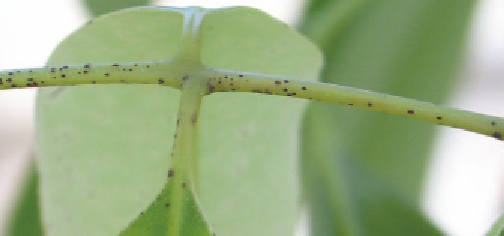Agriculture Reference
In-Depth Information
Source of infection and spread
Infection probably occurs before harvest from air- or
water-borne spores in the case of side lesions and by fungi
colonising stem-end tissue. Fruit-to-fruit spread after
harvest is only likely if temperature if fluctuations cause
condensation inside packages.
Importance
Postharvest fungal rots can cause serious losses of fruit if
suitable treatments are not used.
Management
•
Fungicide applications used to control anthracnose may
provide some control of other postharvest diseases.
Fig 10.5 Detail of pepper spot lesions on fruit.
Cool fruit rapidly after harvest to reduce deterioration of
fruit and disease development.
•
may coalesce to cover the surface of the fruit. Leaves and
petioles may also be affected. Symptoms are generally
worse on lower branches.
Store fruit at 5°C. Maintaining a constant storage
temperature will reduce water condensation, which
encourages disease development.
•
Source of infection and spread
Dead leaves, branches and mummified fruit may act as
inoculum sources. Spores of the fungus are spread by rain
splash. Warm, wet weather favours the development of the
disease.
PEPPER SPOT
■
Cause
The fungus
Colletotrichum gloeosporioides
.
Symptoms
Small, black lesions (around 1 mm in diameter) appear on
the surface of developing or mature fruit, mostly on the
shoulders and stem end of fruit. In severe cases, the spots
Importance
Pepper spot has become a significant problem in the past
20 years. It does not affect the f flesh of the fruit but devalues
it and an extra cost is incurred for sorting the affected fruit.
Management
•
Use appropriate fi eld sprays of protectant fungicides.
Remove dead limbs and mummifi ed fruit from trees to
reduce inoculum.
•
Ensure marcotts are taken from trees that are free from
pepper spot.
•
Fig 10.6 Pepper spot lesions on a leaf petiole.
Fig 10.4 Pepper spot on fruit in the field.














